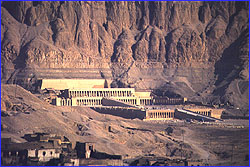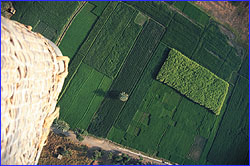
|
 |
 |
Part 2 | Back to Part 1 The Ramesseum Ramses II built more colossal statues of himself than any other pharaoh did. The largest of them once stood here, at his mortuary temple. Weighing over 1,000 tons and once standing nearly 60 feet tall, the seated Colossus of Ramses II now lies broken on the floor of the Ramesseum, its pink-granite blocks offering mute testimony to the mortality of even a spirit as undying as Ramses the Great. In 60 B.C., the chronicler Diodorus of Sicily claims to have translated the hieroglyphic inscription on the statue's base: "King of Kings am I, Ozymandias." [Ozymandias is the Greek version of Ramses II's throne name, User-Maat-Re.] "If anyone would know how great I am ... let him surpass one of my works." Such brazen self-aggrandizement earned him "Ozymandius," Shelley's famous poem, which mocks his aspirations to immortality.
The mortuary temple of Hatshepsut lies snuggled in the Libyan Cliffs at Deir el-Bahari. Half free-standing and half rock-cut, the temple features three rows of colonnades rising ever higher into the cliff, various chapels to the gods hidden in their roofed interiors. Quite unlike any other temple ever built in Egypt, the "Holy of Holies," as Hatshepsut called it, was aligned with her tomb across the hill in the Valley of the Kings. It was also aligned with Karnak temple on the other side of the Nile (see March 10 1999 dispatch). Hatshepsut reigned for 33 years. Like most pharaohs, she was anything but modest and wrote of herself that "Her fragrance was like a divine breath, her skin made of gold, it shines like the stars. She is a great marvel ... She was selected for the protecting of Egypt ... for arousing bravery among men ... She is ... forever and ever...."
To see what the Ramesseum might have looked like in better days, one need look no further than the mortuary temple of Ramses III at Medinet Habu. Known as "The Mansion of Millions of Years of Ramses III," the temple was modeled after the Ramesseum, complete with a hypostyle hall whose reliefs still bear traces of the bright colors with which these temples were painted. Like his famous namesake, Ramses III fought many epic battles abroad, which he had his artisans celebrate on the walls of his "Mansion." The temple's 189-foot-long first pylon, for example, bears well-preserved reliefs of the pharaoh smiting his enemies, whose hair he holds collectively by one hand while raising his other to strike. But Ramses III's death in 1188 B.C. marked the beginning of a long decline of Egyptian civilization, and Medinet Habu was the last of the great mortuary temples to be built.
Before we had climbed into the balloon's wicker basket for the flight, Yehia had given us our instructions for landing: Hold onto ropes inside the basket, bend your knees, and crouch down. But our descent to the field from which we'd taken off an hour before was so smooth that, as I prepared to assume the position, Yehia waved his hand gently, smiled, and said, "There is no need." The crew caught the basket as effortlessly as if it were a small boat gliding onto a beach and placed it gently upon the ground. If you ever have a chance to go "swimming in the air," as one of the balloon crew so aptly put it, don't miss it, especially if it happens to be over ancient Thebes. Next: Tomorrow the NOVA team flies to Aswan, where the attempt to raise the obelisk will begin. Peter Tyson is Online Producer of NOVA. Obelisk Raised! (September 12) In the Groove (September 1) The Third Attempt (August 27) Angle of Repose (March 25) A Tale of Two Obelisks (March 24) Rising Toward the Sun (March 23) Into Position (March 22) On an Anthill in Aswan (March 21) Ready to Go (March 20) Gifts of the River (March 19) By Camel to a Lost Obelisk (March 18) The Unfinished Obelisk (March 16) Pulling Together (March 14) Balloon Flight Over Ancient Thebes (March 12) The Queen Who Would Be King (March 10) Rock of Ages (March 8) The Solar Barque (March 6) Coughing Up an Obelisk (March 4) Explore Ancient Egypt | Raising the Obelisk | Meet the Team Dispatches | Pyramids | E-Mail | Resources Classroom Resources | Site Map | Mysteries of the Nile Home Editor's Picks | Previous Sites | Join Us/E-mail | TV/Web Schedule About NOVA | Teachers | Site Map | Shop | Jobs | Search | To print PBS Online | NOVA Online | WGBH © | Updated November 2000 |
 The Ramesseum from on high. Ramses' enormous statue
lies toppled before the standing columns at right.
The Ramesseum from on high. Ramses' enormous statue
lies toppled before the standing columns at right.
 The remarkable mortuary temple of Queen Hatshepsut
lies nestled in the cliffs at Deir el-Bahari.
The remarkable mortuary temple of Queen Hatshepsut
lies nestled in the cliffs at Deir el-Bahari.
 Medinet Habu, the vast mortuary temple of Ramses III,
stands like a sentinel on the edge of the
desert.
Medinet Habu, the vast mortuary temple of Ramses III,
stands like a sentinel on the edge of the
desert.
 We landed in a lush field near the Ramesseum.
We landed in a lush field near the Ramesseum.